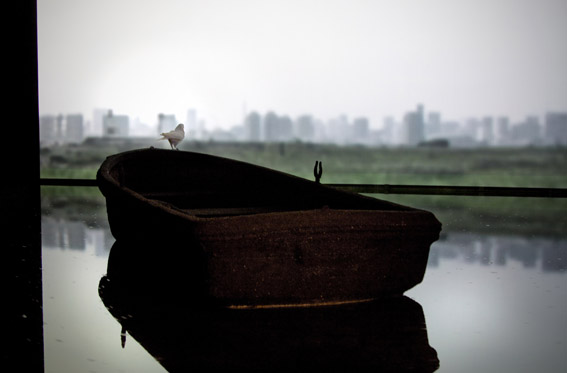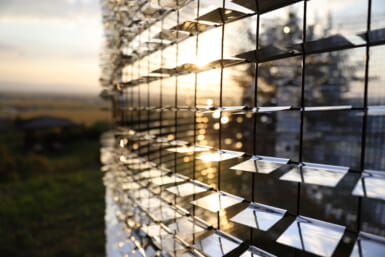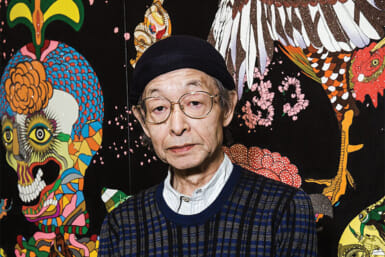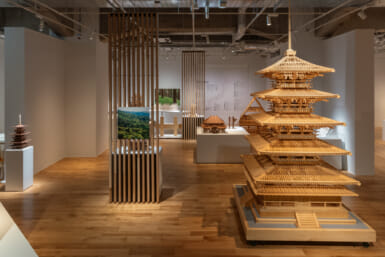by Owen Schaefer
It’s not the usual image of an art exhibition opening―the guests standing at a wary distance from the work, each of them wearing a surgical mask, as if they were in quarantine rather than at a reception. But that was the scene at Shibuya Wonder Site when Shinji Ohmaki filled the upper floor of the gallery with slag―a granular by-product of garbage incineration―and then poked a hole in the ceiling in order to let it drain onto the main floor below.
The result was an eventual Fuji-like cone of the substance on the floor downstairs, and its precise inverse directly above in the bed of slag. It is an installation suggestive of hourglasses and the passage of time; trash heaps and landfills; mountains, landscapes, and balance. And while the performance aspect may be finished―save a passing truck or earthquake dislodging more of the slag from above―it is a simple, almost sculptural work, whose readings spin out in ever widening circles. And as an added bonus, the slag involved was all produced by Tokyo.
But Ohmaki’s waste-filled hourglass is only one part of a three-piece installation entitled Zekkei―a word which translates to ‘superb view,’ but the characters for which can be deconstructed to take on undertones of destruction, separation, and light and shadow. It’s an extension of Ohmaki’s recent studies in trash, and wonderfully ambitious.
Ohmaki is an emerging talent being recognized for installations that set out to redefine gallery spaces. Many of his works have involved creating environments that are altered by their viewers, such as a room filled with hanging threads, called Liminal Air, or the colorful floral sand-patterns created on the floor of Shiseido Gallery which were slowly blurred and even erased by visitors’ feet as they walked through it. These are works with a kind of bright levity to them―highly clever, but also clean and relatively harmless.
Zekkei is anything but. It’s dark―both figuratively and literally―and immersive. And while many artists bog down when it comes to hot-button issues such as the environment, Ohmaki manages to do something rare with this show―he invites dualities into the question, making waste and its byproducts one example of larger systems of change, renewal, and perhaps even entropy. We all know that waste is bad; but what Ohmaki seems to ask is: Where does it fit into our lives?
Addressing this, the two other works in the show bring the outside in. Ohmaki uses more slag―tons of it―to build a grimy artificial beach inside the gallery itself, filling the better part of each room with water. Stepping onto this scorched-earth landscape, viewers find themselves at the edge of what appears to be a small lake―complete with an abandoned boat made of the same stuff, and in the blurry distance, a projected city skyline.
In a connecting room there is almost utter darkness, but across another small pond there is a shifting orange glow projected on the wall and reflected in the water, accompanied by a soundtrack of grating industrial noise. It is the mouth of a burning furnace churning out more slag; it is a dying sun going down on an apocalyptic landscape; it is a light in the darkness. It is an underworld of horrible sterility and beauty, and leaving it is like coming up for air.
Zekkei proves Ohmaki to be more than just a flavor-of-the-month among young Japanese artists. He’s an artist that’s willing to get his hands dirty, and do it with finesse―even if he has to bring the outside in.
Show: Shinji Ohmaki: Zekkei (to Nov 8th)
Gallery: Shibuya Wonder Site (Shibuya station)
Hours: 11am–7pm (closed Mon) Admission: Free
Tel: 03-3463-0603 www.tokyo-ws.org










